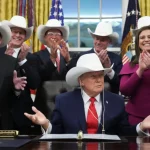
–>
May 27, 2022
On the weekend of May 20, mainland China, recognized by the business community as “a low-cost country,” announced yet another citywide COVID lockdown. This time, it’s the northeastern coastal city of Tianjin, with a population of 14 million, the primary seaport for the nation’s capital city, Beijing.
Tianjin is one of the five biggest cities in China, and is one of the busiest seaports in the world – or at least, it was until this week. Tianjin is a huge manufacturing center, producing cars, clothing, petrochemicals, large and small machinery, even Airbus airplanes (remember when the name Airbus meant it was made in France?). Tianjin is a huge, sprawling, low-cost city, in a huge, sprawling, low-cost country.
Why has so much of the world’s manufacturing moved to Tianjin, and to China in general? Don’t call anyone in Tianjin today to ask. They won’t be in the office. They’re restricted to their homes, as soldiers and bureaucrats with megaphones march down residential streets, enforcing the lockdown.
One recalls an old joke, as recounted by the late, great Leo Rosten in his masterpiece, “The Joys of Yiddish”:
“Forty cents a dozen for bialys?” protested Mrs. Becker. “The baker across the street is asking only twenty!”
“So, buy them across the street.”
“Today, he happens to be sold out.”
“When I’m out of bialys, I charge only twenty cents a dozen, too.”
Like all good jokes, it is rooted in truth, and it has a moral.
Today, that moral applies to the American economy, the labor force, Wall Street, and in fact, to world trade itself: “In the first place, accept reality.”
For forty years, our business schools taught MBA students, engineers, entrepreneurs, and material buyers that low-cost country sourcing is the path to profitability. These students then populated our manufacturing and retail sectors, our franchises, and our investment houses, carrying forth the mantra, “always source from the low-cost country.”
First, they looked to Asia to implement their dual-sourcing programs, until they could be confident in Asia’s quality and bottom-line value. They would continue to rely on domestic vendors as the primary source, but would then gradually grow their dependence on Asia as a secondary source until Asia finally overcame the original, local sources. This practice required two molds for every custom product, two training programs, two quality assurance processes, two logistics paths. But it enabled us to save money while retaining that local dependability.
The cost reductions delivered shareholder value. Or so it seemed.
It meant adding months to every product’s lead time, and increasing the risk of damage or loss in transit as every part must now travel halfway across the world, but it was in compliance with the corporate mantra, and that’s what counts: Low-cost countries maximize profits.
Over the years, as Asian suppliers became more experienced, and more reliable, American companies (and other westerners) gradually dropped that whole dual-sourcing process completely.
Two injection molds? Two stamping dies? Two logistics paths? How wasteful, we determined. Now we buy all our parts from the same vendor in China, and the more customized those parts were, the more entrenched each Chinese vendor became.
There is a corollary, though we don’t like to talk about it. Over these years, many of those American alternatives, once our primary sources, then our secondary sources, then our emergency, just-in-a-pinch sources, dwindled away, finally closing down operations completely. If we need them again, we find they are long gone.
So now we are completely dependent on our Chinese sources. For a shocking amount of products, there simply are no local alternatives, even for more money – we’ve put all the local boys out of business. Domestic foundries, small assemblers, injection molders – one by one, they dwindled away.
Over the past few years, punitive import tariffs and Customs quotas, a global pandemic, port and rail hub bottlenecks, raw material shortages, and skyrocketing transportation costs combined to make China anything but a low-cost country. Transit times have tripled and transportation pricing has quintupled. Lead times are outlandish. The case for reshoring locally could not possibly be clearer.
One would think China would see its edge slipping away. That politburo in Beijing ought to be wracking their brains, trying to think of ways to keep their foreign customer base in the midst of this sea of adversity.
But no. Instead of trying to demonstrate their willingness to improve service, to work around the clock to remain a dependable source, China is instead declaring lockdown after lockdown. Just in the past six months, Xi’an, Shenzhen, Shanghai, Beijing, and now Tianjin, massive cities that all fell victim to authoritarian shutdowns for weeks or months by Chairman Xi Jinping.
Thousands of American companies have been waiting for two months for cargo, finished and packaged, ready for pickup, to move out of their warehouses in Shanghai as its second full month of lockdown arrives, with no end in sight.
The astute among us have known since the beginning that lockdowns don’t reduce the spread of this virus, and we know that it is gradually mutating into one of the familiar seasonal illnesses consistently experienced by society. But Xi Jinping has tied his chairmanship to the COVID lockdown, so he remains committed to the practice.
What this means is that the low-cost and dependability of China as a commerce partner are now permanently compromised – these long-championed positives are nothing but a fiction today…. Even as Western manufacturers continue to put up with their challenges. Why? Because the concept that China is a low-cost country has become an article of faith, impervious to all data to the contrary.
One cannot help but wonder what it will take for the Western business community to acknowledge reality. Decades of intellectual property theft, the production of knockoffs, the forced partnerships with the Chinese government, and now even impossible transit times haven’t shaken their customer base. Now the vendors aren’t even open at all, as their factories and warehouses sit for months at a time, collecting dust, on order from the politburo at Beijing.
And still our business schools, our politicians, and our business community call China a “low-cost country.”
Someday, eventually, the fantasy must give way to a recognition of reality. It has to. But as fantasies go, this one is as persistent as Atlantis, Neverland, and the Fountain of Youth all wrapped up together.
John F. Di Leo is a Chicagoland-based international transportation professional. A one time Milwaukee County Republican Party chairman, he has been writing a regular column for Illinois Review since 2009. His book on vote fraud (The Tales of Little Pavel) and his political satires on the current administration (Evening Soup with Basement Joe, Volumes I and II) are available on Amazon.
‘); googletag.cmd.push(function () { googletag.display(‘div-gpt-ad-1609268089992-0’); }); }
<!– if(page_width_onload <= 479) { document.write("
“); googletag.cmd.push(function() { googletag.display(‘div-gpt-ad-1345489840937-4’); }); } –> If you experience technical problems, please write to [email protected]
FOLLOW US ON
<!–
–>
<!– _qoptions={ qacct:”p-9bKF-NgTuSFM6″ }; ![]() –> <!—-> <!– var addthis_share = { email_template: “new_template” } –>
–> <!—-> <!– var addthis_share = { email_template: “new_template” } –>





